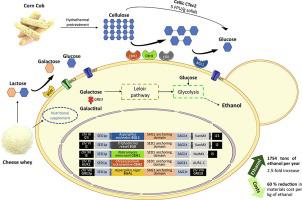Energy Conversion and Management ( IF 10.4 ) Pub Date : 2021-06-16 , DOI: 10.1016/j.enconman.2021.114359 Joana T. Cunha , Daniel G. Gomes , Aloia Romaní , Kentaro Inokuma , Tomohisa Hasunuma , Akihiko Kondo , Lucília Domingues

|
The viability of 2nd generation bioethanol processes is dependent on achieving high ethanol titers, which requires the use of high solid loadings that will negatively affect the fermentative microorganism besides increasing enzyme-associated costs. To solve this, and also problems of feedstock availability, lignocellulosic biomass can be mixed with dairy by-products to increase carbon content. In this study, industrial strains of Saccharomyces cerevisiae, with improved thermotolerance and stress resistance, were engineered for the cell surface display of cellulolytic enzymes and were evaluated in consolidated bioprocessing of cellulose. Additionally, β-galactosidase was also displayed to enable lactose consumption, resulting in high ethanol titers (>50 g/L) from the simultaneous use of cheese whey and pretreated corn cob as substrate. The multi-feedstock valorization approach together with this lactose-consuming cellulolytic yeast allowed the reduction on materials costs by 60% with a 2.5-fold increase in the annual ethanol production, therefore contributing to the establishment of economic viable ethanol processes.
中文翻译:

酿酒酵母的细胞表面工程通过乙醇生产同时使玉米芯和奶酪乳清增值
第二代生物乙醇工艺的可行性取决于实现高乙醇滴度,这需要使用高固体负载,除了增加酶相关成本之外,这将对发酵微生物产生负面影响。为了解决这个问题以及原料可用性问题,木质纤维素生物质可以与乳制品副产品混合以增加碳含量。在本研究中,酿酒酵母的工业菌株具有改进的耐热性和抗压性,专为纤维素分解酶的细胞表面展示而设计,并在纤维素的综合生物加工中进行了评估。此外,β-半乳糖苷酶也被证明可以消耗乳糖,同时使用奶酪乳清和预处理的玉米芯作为底物,从而产生高乙醇滴度(>50 g/L)。多原料价值化方法与这种消耗乳糖的纤维素分解酵母相结合,使材料成本降低了 60%,乙醇年产量增加了 2.5 倍,因此有助于建立经济可行的乙醇工艺。



























 京公网安备 11010802027423号
京公网安备 11010802027423号